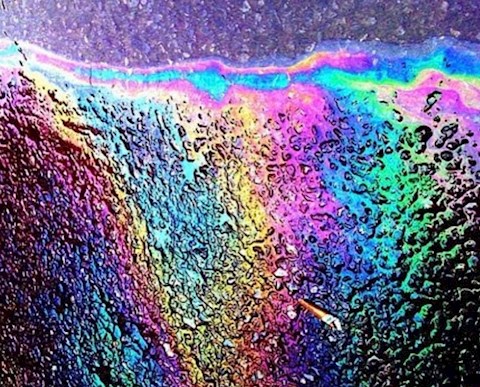>
#oil-puddle
,
#oil-spill
,
#driveway
,
#colors
,
#rainbow
,
#rainbow-colors
,
#science
,
#interesting-facts
,
#general-knowledge
>
Why do oily puddles on the driveway have rainbow colors?
Anonymous
Mar 27, 2020
#oil-puddle
#oil-spill
#driveway
#colors
#rainbow
#rainbow-colors
#science
#interesting-facts
#general-knowledge
Why do oily puddles on the driveway have rainbow colors?
What do a clear (clean) soap bubble and a dark (dirty) oil spill have in common?

2 answers
Sort By
Anonymous
Mar 27, 2020
Their floaty rainbow colors are the result of waves of light, getting in each other’s way.
White light from the Sun contains a hidden rainbow of colors, each color a different wavelength. You can see this rainbow when light passes through a prism, and its colors spill out onto the wall. Thin layers on a surface, such as a film of oil or soap on water, can also tease the rainbow out of white light, creating an iridescent sheen.
How? When light strikes an oily puddle or soap bubble, some rays immediately bounce off the outside surface. But others penetrate into the thin film before reemerging. Since these rays travel a slightly longer path, they are slightly out of sync with the others when they emerge at the surface.
Now, imagine waves on the ocean. If two waves meet and match up, peak to peak, the resulting wave will be strongly reinforced. But if the peak of one wave meets up with the trough (low point) of another, the two cancel each other out.
Something similar happens with light waves. Scientists call this process interference. When the peaks of light waves exactly (or almost) coincide, the light brightens. But if one wave’s crest matches up with another’s trough, the two cancel each other out, making a dim or dark spot. So when light waves combine and interfere at the surface of a thin layer, colors are reinforced—or canceled. For example, a yellow wave peak matching up with a purplish-pink peak produces red.
When a crest matches to a trough and colors get canceled, we see their “complementary colors,” their color opposites. So when red waves are canceled, blue-green hues emerge. Where blues are canceled, yellows bloom. The result, in an oil slick or soap bubble, is an assortment of brilliant, swirling colors.
The exact colors you see depend on your own viewing angle, and on the depth of the thin film (say, oil). Scientists can actually determine a film’s thickness by the colors that pattern its surface, since they reveal what happened to the emerging light.
As a soap bubble evaporates, the colors change more than those on a puddle. Gravity pulls water toward the bottom, thinning the top wall and making colors shift and swirl.
0
Anonymous
Mar 27, 2020
Interference happens in more than oil slicks and soap bubbles. It’s why you see a gleaming rainbow in the surface of a DVD. Shimmery, iridescent colors appear in everything from pearls to peacock feathers, beetles to butterfly wings—on any object that has a thin film to redirect light.
Ordinary color, such as the red of a robin’s chest, or the orange of a monarch butterfly’s wings, comes from pigments. The pigment melanin, for example, gives our skin, hair, and eyes their color. And in autumn, anthocyanin pigments color leaves red and purple.
But it’s the structure of an object that produces a rainbow effect.
Take butterfly wings. Their standard colors come from pigments. Their iridescent colors appear because of wing structure. How? Butterfly wings contain very thin layers of chitin—the hard material that makes shells for insects and shellfish—separated by air. So each thin layer is like the thin film in an oil slick, and each layer makes light iridesce. Multiple layers produce spectacular effects making butterfly wings shine far more brilliantly than a roadside pool of oil.
0